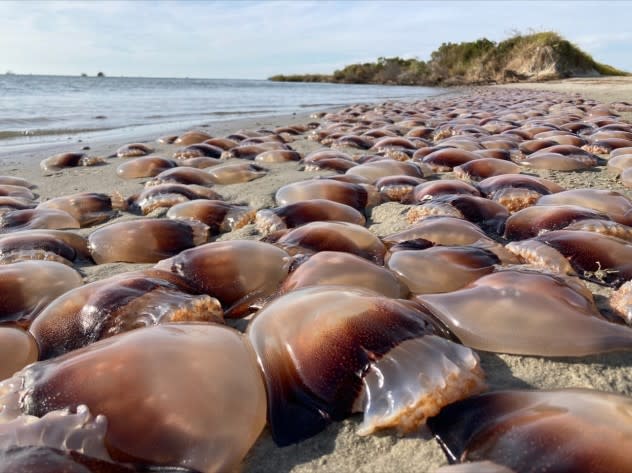‘A lot of squishy': Swarm of jellyfish plasters popular coastal area
 |
Hundreds of cannonball jellyfish washed ashore on Ocracoke Island, North Carolina, on Oct. 12, 2022. (Cape Hatteras National Seashore) |
A typical day on the enchanting Ocracoke Island, part of North Carolina's Outer Banks, was slightly disrupted by hundreds of squishy, gelatinous creatures that washed up on the shore Wednesday.
The Cape Hatteras National Seashore, which is a part of the National Park Service (NPS), cleared up any confusion for locals or tourists who may have encountered the "jellyfish jamboree" during their visit to the beach.
"A large swarm of Cannonball Jellyfish have washed up on the North end of Ocracoke Island," officials said in a Facebook post.
According to the NPS, jellyfish whereabouts depend on water, winds and currents, which help them swim. However, colder waters, winds and currents can all be responsible for directing them toward land.
"Although this particular species generally doesn't sting, please avoid handling them," the park advised.
The NPS said these jellyfish typically feast on zooplankton and larvae of red drum fish. As it so happens, the red drum fish are currently spawning, providing more food opportunities for the jellyfish.
The Georgia Department of Natural Resources describes cannonball jellyfish to be the most prominent species of jellyfish on the southeastern coast of the country, especially in fall and summer when they are "incredibly abundant."
These jellyfish invasions can happen throughout the Outer Banks. According to the Outer Banks Vacations website, cannonball jellyfish have a "round, cannonball-like dome that is often brown with a tiny cluster of arms underneath."
The photos that the NPS shared generated quite a range of reactions from Facebook commenters. Some appeared to be in awe, while others appeared disgusted.
"That's a lot of ‘squishy' right there!" someone said. Others shared their discoveries of jellyfish being able to "swim... somewhat," or just simply said "Gross!"
According to the NPS, the jellyfish will be left onshore to let "nature take its course," meaning some could either be washed back out with the tide or eventually become food for birds or crabs that live around the seashore.
Want next-level safety, ad-free? Unlock advanced, hyperlocal severe weather alerts when you subscribe to Premium+ on the AccuWeather app. AccuWeather Alerts™ are prompted by our expert meteorologists who monitor and analyze dangerous weather risks 24/7 to keep you and your family safer.


